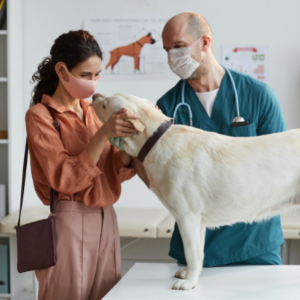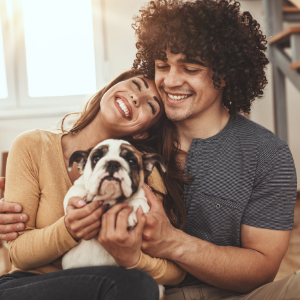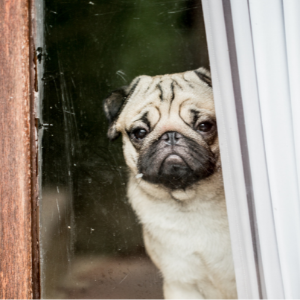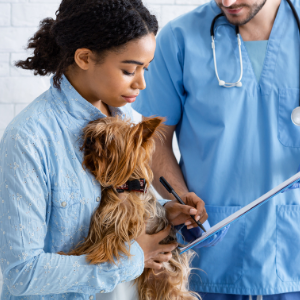 Web Content Viewer
Web Content Viewer
Animal Behavior in a Post-COVID World
Published on 5/5/21

By Amy L. Pike, DVM, DACVB
Things Are Looking Up
It has been a tough year for everyone in the veterinary field (ok, that may be the understatement of the year). Between switching to curbside medicine, dealing with irate owners, or working longer hours with fewer staff for double the clients and patients, it goes without saying that we all hope the pandemic will be over soon.
However, the end of the pandemic will usher in new challenges within the field that may be just as frustrating to address, especially if the mere mention of behavior sends you running for the nearest referral brochure or crying in the bathroom in between appointments.


What about Pets Acquired in the Past Year?
Any of our pets could see lifestyle changes once normalcy returns, but my biggest post-pandemic behavior concerns lie with those dogs and cats who were acquired during this last year. The threat of social isolation from loved ones, and the seemingly perfect opportunity to be home caused so many people to rush out and get a pandemic pet.
And while these pets have likely been emotional life lines for many humans during this time, these dogs and cats have no idea what “normal” is for their families. The lack of appropriate socialization and interactions with other pets and people may set many of these patients up for a lifetime of fear-based behavior, but the area to address here is the possibility of post-pandemic separation anxiety development.
On our new client questionnaire, we ask how long the pet is left home alone during the day and I cannot tell you how many of those have been filled out with some form of the following this past year- “they have never been left home alone”.

Will the Pet Experience Separation Anxiety?
Does that mean that every one of these animals is going to develop separation anxiety post-pandemic? That’s really unlikely, but of course in these unprecedented times, we just don’t know what the fallout will truly be.
Whether or not a particular pet is going to manifest separation anxiety is going to depend on some innate factors about the pets themselves. Examples include:
- The pet’s individual emotional resiliency
- The pet’s level of pathologic attachment to the owner
- The pet’s underlying predisposition to anxiety and panic disorders
- Environmental factors like if the owner will be allowed to work from home part-time or start only with half days?
- The pet’s prior learning and experiences including if there has there been appropriate reinforcement for independent behavior, excessive attention seeking rewarded in the past, & separation anxiety prior to relinquishment by a former owner
Screening for Symptoms of Separation Anxiety
What should be done to prevent and screen for this disorder? First, if the owners are not already doing so, encourage them to actually leave their pets home alone on occasion. Next, screen for signs of separation anxiety and its common comorbidities, including noise and storm phobias1,2.
This can be done by the client care representatives:
- When they speak to the owner to make appointments
- Via a written questionnaire the owners fill out in advance (ask your friendly pharmaceutical representatives because they often have these available)
- By the assistant or nurse when they perform vital signs and take the chief complaint history
- Or even the clinician while you are performing the physical exam on the pet or when discussing your findings.

Owners should be asked if there are any obvious signs such as house soiling, destruction, or vocalization when the pet is left home alone. A full physical exam and diagnostics (Minimum database of CBC, chemistry panel, urinalysis and fecal) will rule out a medical etiology, and videoing the pet when home alone will then confirm the underlying behavioral cause.
Use Video as a Screening Tool
There are subtle presenting symptoms that indicate the owner needs to video to confirm if the pet is suffering from separation anxiety such as:
- Anorexia when alone
- Polydipsia upon owner return (likely the result of lack of drinking and/or excessive panting)
- Blocking the owner’s exit from the home
- Avoidance of confinement
- Hyperattachment (following owners excessively)
- Exuberant greeting upon owner return.
Any signs of anxiety seen on video are too many and need to be addressed immediately.
Treatment for Separation Anxiety
Treatment for separation anxiety involves behavior modification and depending on the severity, anxiolytic products and medication. Instruct the clients to leave the pet with a delicious snack like a frozen Kong or puzzle toy to not only keep them occupied, but also to help associate the owner’s departure with something amazing.


The owners should remain calm and ignore the pet for 20-30 minutes prior to leaving so as not to create a heightened state of arousal just prior to departure. Owners should never ever punish the pet for house soiling or destruction as it will only serve to increase the anxiety associated with anticipation of the owner’s return.
There are two medications FDA-approved for use in dogs with separation anxiety. One of them is Reconcile® (fluoxetine, a selective serotonin reuptake inhibitor) by PRN® Pharmacal3,4, which is a treatment for separation anxiety when used in combination with a behavior modification program. For more client information on the initial training steps for separation anxiety, please visit: Reconcile.com.
Another great client resource is the newest edition of Separation Anxiety in Dogs: Next Generation Treatment Protocols and Practices.
Clomipramine, a tri-cyclic antidepressant5,6 is another FDA-approved medication. Both Reconcile and clomipramine may take up to 4 weeks to see full effect and should always be started at the low end of the dose range to minimize potential for side effects and increased only as needed.
In the meantime, clinicians can prescribe event/situational medications to be given immediately prior to departures. Options for predeparture medications (given 90 minutes to 2 hours prior to departures) include the serotonin antagonist and reuptake inhibitor, trazodone (2.5-10 mg/kg), the alpha-2 agonist, clonidine (0.01-0.05 mg/kg), the alpha-2-delta ligand, gabapentin (20-40 mg/kg), and a benzodiazepine like lorazepam (0.01-0.1 mg/kg). Other products which may improve treatment outcomes include the maternal appeasing pheromone7,8, l-theanine supplements10, probiotics11, and alpha-casozepine supplementation12.
Resources
With all the excitement of normalcy returning (and maybe traveling to conferences again!), don’t forget that your clients are headed back to work and their pets are staying home, maybe for the first time ever. And if the mere mention of a dog howling all day and destroying the house, or a cat peeing outside a litter box when the owner is gone makes you want to quit vet med and work at home in your pajamas, feel free to find me or my colleagues for some advice or a referral through this resource: (https://www.dacvb.org/search/custom.asp?id=4709).
Bio on Dr. Pike

"Dr. Pike graduated from Colorado State University in 2003. After graduation, she was commissioned as a Captain into the Army Veterinary Corps where taking care of the Military Working Dogs returning from deployment spurred her interests in behavior medicine. Dr. Pike completed a Residency program under Dr. Debra Horwitz, DACVB and became board certified in 2015.
Dr. Pike is owner of the Animal Behavior Wellness Center with locations in Richmond and Fairfax Virginia. She currently has 3 residents in behavior medicine programs, including one in Louisville KY where she herself practiced for 2 years after getting board certified.
Dr. Pike was recently named one of the “Top Veterinarians of Northern Virginia” by NoVa Magazine for the fourth year in a row. In her ample spare time (ha ha) she loves to garden, hang out with her husband and kids (daughter, age 13 and son, age 7) and her giant schnauzer, scottish terrier, mini schnauzer, devon rex cat, 27 year old African Ringneck parakeet, and the latest Pike family member, their hedgehog."
References:
- Bamberger, Michelle, and Katherine A. Houpt. "Signalment factors, comorbidity, and trends in behavior diagnoses in dogs: 1,644 cases (1991–2001)." Journal of the American Veterinary Medical Association 229.10 (2006): 1591-1601.
- Overall, Karen L., Arthur E. Dunham, and Diane Frank. "Frequency of nonspecific clinical signs in dogs with separation anxiety, thunderstorm phobia, and noise phobia, alone or in combination." Journal of the American Veterinary Medical Association 219.4 (2001): 467-473.
- Simpson, Barbara Sherman, et al. "Effects of reconcile (fluoxetine) chewable tablets plus behavior management for canine separation anxiety." Veterinary Therapeutics 8.1 (2007): 18.
- Landsberg, Gary M., et al. "Effectiveness of fluoxetine chewable tablets in the treatment of canine separation anxiety." Journal of veterinary behavior 3.1 (2008): 12-19.
- King, J. N., et al. "Treatment of separation anxiety in dogs with clomipramine: results from a prospective, randomized, double-blind, placebo-controlled, parallel-group, multicenter clinical trial." Applied Animal Behaviour Science 67.4 (2000): 255-275.
- King, J. N., et al. "Results of a follow-up investigation to a clinical trial testing the efficacy of clomipramine in the treatment of separation anxiety in dogs." Applied Animal Behaviour Science 89.3-4 (2004): 233-242.
- Gaultier, Emmanuel, et al. "Comparison of the efficacy of a synthetic dog‐appeasing pheromone with clomipramine for the treatment of separation‐related disorders in dogs." Veterinary record 156.17 (2005): 533-538.
- Kim, Young-Mee, et al. "Efficacy of dog-appeasing pheromone (DAP) for ameliorating separation-related behavioral signs in hospitalized dogs." The Canadian Veterinary Journal 51.4 (2010): 380.
- Pike, Amy L., Debra F. Horwitz, and Heidi Lobprise. "An open-label prospective study of the use of l-theanine (Anxitane) in storm-sensitive client-owned dogs." Journal of Veterinary Behavior 10.4 (2015): 324-331.
- DePorter, T. L., D. L. Bledsoe, and J. R. Conley. "Case report series of clinical effectiveness and safety of Solliquin™ for behavioral support in dogs and cats." Veterinary Behavior Symposium Proceedings. San Antonio (TX). 2016.
- McGowan, R. T. S., et al. "Tapping into those ‘gut feelings’: Impact of BL999 (Bifidobacterium longum) on anxiety in dogs." Veterinary Behavior Symposium Proceedings, Denver, CO. 2018.
- Beata, Claude, et al. "Effects of alpha-casozepine (Zylkene) versus selegiline hydrochloride (Selgian, Anipryl) on anxiety disorders in dogs." Journal of Veterinary Behavior 2.5 (2007): 175-183.